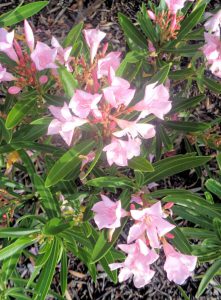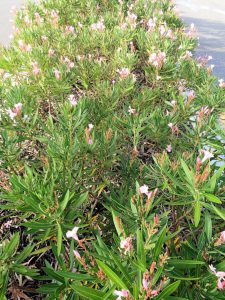
The oleander is a very common landscape plant in Charlotte County. This evergreen plant does provide substantial blooming power and is a useful subject for hedges and as specimen plants. While you more often may see full-sized oleander varieties ten to eighteen-feet tall, there are dwarf cultivars which average only three to four feet – less need for pruning. Dwarf oleanders are very versatile and adaptable plants with beautiful blooms and eye appeal.
Right up front, keep in mind that oleanders are poisonous. As a matter of fact, all parts of oleanders are poisonous and should be planted in areas where direct contact with people will be limited – especially children and curious pets. Oleander are considered a toxic plant capable of poisoning or killing both humans and livestock. Symptoms of poisoning from consumption of leaves includes severe gastroenteritis, diarrhea, abdominal pain, sweating and weakness. Heart rate is also affected. If ingestion is suspected, immediately contact a physician, hospital or poison control center. To prevent poisonings, plant oleander at sites in your landscape where people will not come in direct contact. Parents should avoid planting oleander in their landscapes where small children could accidentally consume the plant. Never burn this plant when disposing of pruned branches! The airborne oils may cause respiratory problems from inhaling the smoke. Also, keep pets and livestock away from this plant. Oleanders do not have to be completely barred from all landscapes, but education as to common-sense precautions and plant placements will limit the danger of poisoning.

Perhaps the only benefit provided by the toxic nature of oleanders is that rabbits (and deer) tend to leave it alone! With this in mind, the dwarf oleanders commonly found include the cultivars ‘Petite Pink’ and ‘Petite Salmon’. Another cultivar called ‘Little Red’ grows a bit taller to six-feet tall and wide with deep red blooms. Rarely needing trimming, these varieties are great subjects for sunny areas where their drought-tolerance and adaption to seaside plantings can be showcased. Dwarf oleanders are great for short, managed borders, and even take well to container culture. While oleanders require regular watering during establishment, they are able to take droughty conditions better than many plants. Additionally, these landscape subjects have low fertilizer needs and established plants actually have little to no supplemental fertilizer requirements.
All oleanders are generally pest-free with the exception of the insidious oleander caterpillar. This orange and black moth larva is probably the most common pest of oleander referred to our office for identification. The moth is truly beautiful and easy to identify – purple/blue-black wings and body covered with white dots topped off with a red-tipped abdomen. Common in March, July and December, the adult female moth lays up to 75 orange eggs. The resulting caterpillars can literally defoliate this shrub making it an eyesore. Damaged shrubs will grow back however, but repeated defoliations may weaken the shrub. The caterpillars can be managed when small with the biological control, Bacillus thuringensis or Bt available at most garden centers. Used according to label instructions, this least-toxic material affects only caterpillars. Predatory stink bugs will also take their share of oleander caterpillars, as will a variety of other predators and parasites.
In spite of its cautions, the dwarf oleander is a Florida-Friendly Landscaping™ recommended plant suitable for planting in our area! Dwarf oleanders are particularly nice for small-space gardens and should be used more often taking into consideration their toxic potential. For more information on flowering shrubs (and even toxic plants), , you can also call the Master Gardener Volunteer Helpdesk on Mondays, Wednesdays and Fridays from 1 to 4 pm at 764-4340 for gardening help and insight into their role as an Extension volunteer. Ralph E. Mitchell is the Director/Horticulture Agent for the UF/IFAS Charlotte County Extension Service. He can be reached at 941-764-4344 or ralph.mitchell@charlottecountyfl.gov.
Resources:
Gilman E. F., Watson, D. G., Klein, R. W., Koeser, A. K. Hilbert D. R., & McLean, D. C. (2018) Nerium oleander: Oleander. The University of Florida Extension Services, IFAS.
The Florida-Friendly Landscaping™ Guide to Plant Selection & Landscape Design (2010) The University of Florida Extension Services, IFAS.
McAuslane H., (2020) Featured Creatures Oleander Caterpillar. The University of Florida, IFAS.
Landre, C. (2020) Dwarf Oleander – Nerium oleander, ‘Petite Pink’ South-Florida-Plant-Guide.com.
Russ, K., Polomski, R. F. & Williamson, J. (2019) Oleander. Clemson University Cooperative Extension Service.
Dave’s Garden (2022) Oleander – Nerium oleander ‘Little Red’.
 0
0
